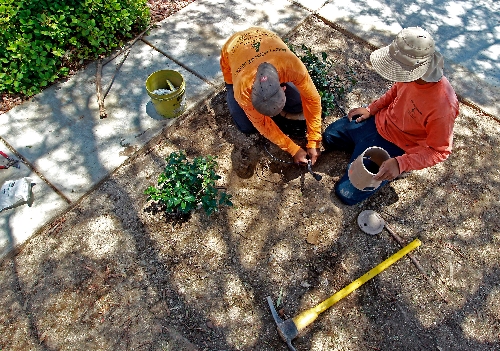Southern Nevada water conservation efforts heralded
Spurred by conservation efforts in Southern Nevada and elsewhere, per-capita water use on the Colorado River declined significantly while the West boomed over the past two decades.
A new report by the Pacific Institute shows per capita use fell by an average of at least 1 percent a year from 1990 to 2008, a period that saw the population in the Colorado River basin swell by more than 10 million people.
Some of the most impressive water-efficiency improvements came in the Las Vegas Valley, where individuals cut their use by roughly one-third while the population almost tripled.
"Southern Nevada has done very well. Their use has declined dramatically," said researcher Michael Cohen, who authored the report for the Oakland, Calif.-based environmental think tank.
In 1990, the average valley resident consumed 347 gallons of water per day. By 2008, the last year included in the report, that figure had dropped to 248 gallons per day thanks in large part to several communitywide restrictions and incentives aimed at saving water.
As the valley's population boomed, the Southern Nevada Water Authority and its member utilities responded with assigned watering days and a ban on front lawns for new homes. They started paying residents and businesses to rip out thirsty grass and make other efficiency improvements.
"I'm pleased to see Southern Nevada is being acknowledged for the conservation gains it has made," said Doug Bennett, conservation manager for the Southern Nevada Water Authority.
The valley's consumption figures include all household water use from the bathroom to the backyard. Landscape watering accounts for about 65 percent of all municipal use.
Bennett said one of the toughest tasks was educating people about where the valley's water flows.
Some residents were reluctant to change their behavior because they mistakenly believed the casinos on the Strip were the biggest and most wasteful water users. In fact, the resort industry accounts for roughly 70 percent of the valley's economy while using 3 percent of its water to supply about 37 million visitors a year, Bennett said.
Today, he sees evidence of the valley's conservation ethic anytime he drives through a neighborhood he hasn't been to in a while.
"It's gratifying to see how Southern Nevadans have changed the landscape over the past decade," he said. "Ten years ago, we literally had small navigable streams running down some of the streets."
Bennett said the valley's per capita water use has gone down even more since 2008.
It now is about 223 gallons per day, an improvement that probably has as much to do with the economic downturn as anything. After all, Bennett said, the community is now dotted with shuttered storefronts and vacant homes where none of the plants is being watered or swimming pools filled.
The Pacific Institute has been critical of valley water managers in the past. In a 2007 report titled "Hidden Oasis: Water Conservation and Efficiency in Las Vegas," the group argued that far more could be done to curb indoor water use and reduce the amount of turf grass.
Now, the institute considers Southern Nevada a shining example of efficiency improvement, right alongside Albuquerque, N.M., and Phoenix, which cut their per capita use by 38 percent and 30 percent respectively.
The most impressive gains came in Southern California, where water agencies managed to deliver 4 percent less water overall in 2008 than they had in 1990 despite the addition of 3.6 million more residents.
The Pacific Institute estimates that water taken from streams and rivers and pumped from the ground within the Colorado River basin now meets some or all of the needs of almost 35 million people from Cheyenne, Wyo., to Tijuana, Mexico.
The Las Vegas Valley draws 90 percent of its drinking water from the river by way of Lake Mead.
Cohen said he decided to research per capita use on the Colorado because he couldn't find updated figures on the subject. The report only looks at municipal deliveries, which is the fastest-growing sector of water use on the Colorado but only accounts for about 15 percent of total diversions.
Some 70 percent of the water from the river system goes to irrigate crops.
Cohen said water demands in the Colorado River basin now exceed supply, but that imbalance would be "much worse" if municipal water agencies across the region had not pushed efficiency improvements.
"Many agencies have demonstrated that more efficient use is clearly possible, and water conservation and efficiency can help the Western U.S. cope with future droughts and climate change impacts," he said.
Contact reporter Henry Brean at hbrean@reviewjournal.com or 702-383-0350.

















